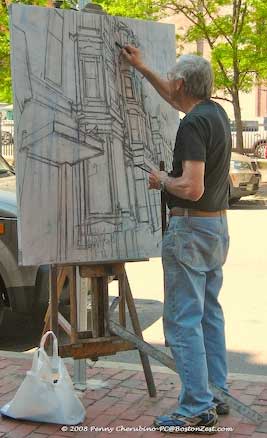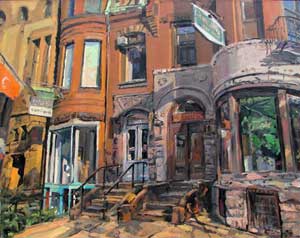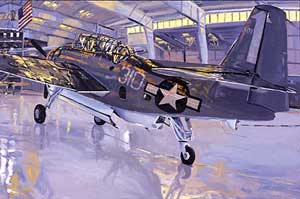
George Nick drawing for a painting on site 2008 from the BostonZest.com
Interview with George Nick, Part Five, On Drawing
Larry Groff:
You often spend a great deal of time on the drawing for your larger, more complex paintings, sometimes spending weeks before starting to paint.
Do you work out the compositions by looking through the viewfinder before you start drawing, or does the composition evolve during the drawing process? What aspects of your drawing particularly needs to be perfect, before you will start painting?
George Nick:
Well, I don’t know, I get hysterical about the drawing, sometimes. Foreshorten the ellipse of the wheel, or something like that. I’m embarrassed if I look at a painting, later on, and find a mistake in the painting. It can drive me crazy, so I don’t want any kind of stupidities to be visible to other people. That’s part of that.
And sometimes I just do a scribble that takes about four seconds, when I’m working on a bad painting: a horizontal line, a long clump …
Drawing varies. Generally, it’s a careful drawing, because everything I do these days, even though it’s a 20 x 30, which is small for me, is drawn pretty conscientiously, without details, but the large forms and large, important parts. And that means the correct angle, the right proportion, and it looks like a Rolls-Royce or a shack. It doesn’t look like Elizabeth Taylor, or something like that.
When I work in a big painting, I work it all out before I start, to one-quarter inch on the edge of a 40 x 60 has to be perfect. It’s figured out. I have arguments about what I want inside of it, how much, what angle, all this kind of stuff. I have to be confident, and that’s why I take so long for the drawing, because sometimes I change the drawing and move it around, and I change the composition, because as I’m drawing it, something doesn’t feel right.
So I’ve got a lot of things going on, before I commit myself, because I don’t treat these things lightly. Once I’ve started, it’s a big commitment to work on a big painting, because I know the work it takes. And if I’m not hot about it, it goes down the drain very quickly. So I feel myself out, at the same time, a lot of times, when on a longer one.
What it does, it’ll generally get me excited about what I’m going to be making — some of the colors, some of the reflections, some of the things here and there. I make notes, unconscious notes, in anticipation of the actual painting of it, after I get the drawing blocked out.

George Nick Memories of Caesar’s Forum 2008 oil on linen 40 x 50 inches
And I don’t feel so bad about it, because Bellotto, Canaletto’s nephew, I saw some drawings of his, and the drawings were simply amazing drawings. They were simply line drawings, with what I do, but with great elegance and great perfection, and it excited me a lot to see those, after I had been doing this for a long time.
And I said, “Well, it’s okay to do that,” because I was trained not to do any drawing. We would come in, and Dickinson would say at the model, standing there, “We’re doing a full, life-sized painting,” and he would say, “Let’s start the painting now from the right, little finger.” You had to be good to do that, you know. We were trained. We could do all these acrobatic kind of activities. It doesn’t mean anything, but it gave us a lot of confidence, that we could do that.
And generally, when I’m working small or fast I’ll just use my hand for a finder, xand I don’t care how it bends and turns and doesn’t quite work out. But when I’m doing a bigger one, I’m really balancing a lot of factors, and I want them in there, or I don’t want them in there, or this is going to do that, or that’s going to do this. I’ve got all these things moving in my brain.
I want to be at peace, or happy, because sometimes when I do a scribble of something I’m going to do a big painting of, and I see that — I don’t care what’s wrong, but if I see there’s a lot of life in it — and it’s wrong, it doesn’t bother me. It shows me that I’m excited by the painting, the subject, and it’s going to come well. I have these black magic ideas about painting, about things like that. I get the feeling, after I’ve done a good drawing, that it is going to be a good painting, a worthwhile event.
That’s the kind of thing I need, I’ve always needed, and I like it. I like to work that way. Then there are large areas that have no drawing in them at all, and I’m going to wing it, because I’m not going to fiddle around with leaves, and with reflections. I’m going to make that at the time, even though, after a while, I’ll be spending weeks on a couple of different shapes in those reflections. It’s enough to get me going, because they’re going to be in the right spot, and the drawing makes sure that I’m in the right place.

George Nick Grumman TBM Avenger 2006 oil on linen 40 x 60 inches
To Interview with George Nick, Part One, On Edwin Dickinson
To Interview with George Nick, Part Two, On Fairfield Porter
To Interview with George Nick Part Three, On George Bellows
To Interview with George Nick Part Four, On Cezanne and color
To Interview with George Nick Part Five, On Drawing
To Interview with George Nick Part Six, On The Trojan Horse and thoughts on Teaching





It is always encouraging and inspiring when a painter see a strong drawing, no matter if there are some perspective bending (which might add to the success of a piece). Skills counts.
Hi Larry,
Great to read your interview with George Nick. Today I read the full length of the interview for the first time, and it was a great pleasure.
I have known George for over thirty years, and I consider him my mentor. Your interview is indeed a great summary of his thoughts about painting, which are important for artists like us to read.
One specific comment, the comment by the boy on the color of the building, reminded me of a similar comment by a professor working in the field of vision research, who asked me the same question. His comment made me interested in perception, and how we can find a common language with people who research vision scientifically.
Your blog is great, I enjoy it very much.
Best regards,
Shalom Flash
The first time I have seen your work and thoroughly enjoyed reading about your experience of the creative process…very inspiring indeed.